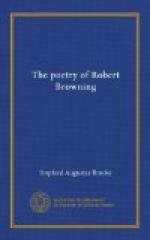That is as splendid as the thing itself.
Again, no one can help observing in all these quotations the extraordinary love of colour, a love Tennyson has in far fainter measure, but which Browning seems to possess more than any other English poet. Only Sir Walter Scott approaches him in this. Scott, knowing the Highlands, knew dark magnificence of colour. But Browning’s love of colour arose from his having lived so long in Italy, where the light is so pure, clear, and brilliant that colour is more intense, and at dawn and sunset more deep, delicate, and various than it is in our land. Sometimes, as Ruskin says, “it is not colour, it is conflagration”; but wherever it is, in the bell of a flower, on the edge of a cloud, on the back of a lizard, on the veins of a lichen, it strikes in Browning’s verse at our eyes, and he only, in English poetry, has joy enough in it to be its full interpreter.
He sees the wild tulip blow out its great red bell; he sees the thin clear bubble of blood at its tip; he sees the spike of gold which burns deep in the bluebell’s womb; the corals that, like lamps, disperse thick red flame through the dusk green universe of the ocean; the lakes which, when the morn breaks,
Blaze like a wyvern flying round the sun;
the woodland brake whose withered fern Dawn feeds with gold; the moon carried oft at sunrise in purple fire; the larch-blooms crisp and pink; the sanguine heart of the pomegranate; the filberts russet-sheathed and velvet-capped; the poppies crimson to blackness; the red fans of the butterfly falling on the rock like a drop of fire from a brandished torch; the star-fish, rose-jacynth to the finger-tips; and a hundred other passionate seizures of colour. And, for the last of these colour remembrances, in quieter tints—almost in black and white—I quote this lovely verse from James Lee’s Wife:
The swallow has set her six
young on the rail,
And looks seaward:
The water’s in stripes
like a snake, olive pale
To the leeward,—
On the weather-side, black,
spotted white with the wind.
“Good fortune
departs, and disaster’s behind”—
Hark, the wind with its wants
and its infinite wail!
So, not only do we possess all these landscapes but we possess them in colour. They are painted as well as drawn. It is his love of colour which made at least half of the impulse that drove him at times into Impressionism. Good drawing is little to the impressionist painters. It is the sudden glow, splash or flicker of colour that moves them, which makes on them the swift, the momentary impression they wish to record.
And colour acted on Browning in the same way. I said he had been impressionist, when he liked, for forty years before Impressionism was born in modern art. He was so, because from the beginning he saw things in colour, more than in light and shade. It is well worth a reader’s while to search him for colour-impressions. I take one, for example, with the black horse flung in at the end exactly in the way an artist would do it who loved a flash of black life midst of a dead expanse of gold and green:




